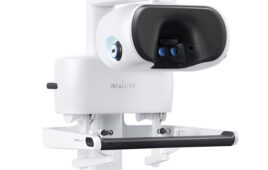The deadline to comply with new medical device regulations in the European Union is coming up fast. Here are some ideas on getting ready for the changes.
Mike Edwards, Sparta Systems

[Image courtesy of Google Satellite]
EU MDR replaces Directive 93/42/EEC for medical devices (MDD) and Directive 90/385/EEC for active implantable medical devices (AIMDD). One of the reasons for this major change is the need for greater control of medical device reporting, which aims to minimize country-by-country differences in regulations and product quality. In describing the purpose of the new EU MDR, the Official Journal of the European Union explains:
“This Regulation aims to ensure the smooth functioning of the internal market as regards medical devices, taking as a base a high level of protection of health for patients and users, and taking into account the small- and medium-sized enterprises that are active in this sector… At the same time, this Regulation sets high standards of quality and safety for medical devices in order to meet common safety concerns as regards such products.”
Though many EU MDR requirements are similar to current requirements under the MDD, the MDR is much more prescriptive and provides greater detail and direction to manufacturers. For example, manufacturers and their authorized representatives must provide regulatory bodies with considerably more data and information than they may have been accustomed to in the past.
While the EU MDR goes into extensive detail about the changes, key requirements to note include:
- Clinical investigations: Requirements for conducting clinical investigations differ greatly from those in the MDD but will align with requirements elsewhere in the world.
- Clinical evaluation: The EU MDR significantly expands manufacturer pre-market clinical evaluation requirements, requiring substantially more clinical evidence supporting device efficacy and safety.
- Notified bodies: Manufacturers will face greater scrutiny from the notified bodies that perform pre-market assessments and routine surveillance audits to consider the conformity of products before they are put on the market.
Two years might seem like plenty of lead time to ensure compliance, but time may actually be the most challenging aspect of the transition to the new requirements. To fully understand the EU MDR, this process can prompt new challenges and will be incredibly time consuming – but it can be done with a strategic approach. Here are four best practices to successfully rollout MDR-ready processes:
- Get smart early and plan ahead. The new EU MDR involves many changes to existing processes and protocols – some more significant than others – so every team member should receive the proper education on the new requirements early on.
- Conduct a thorough assessment. Under the new EU MDR, there will be no grandfathering of legacy or pre-MDR devices. Once the 2020 deadline arrives, every device must be fully compliant. To make sure nothing slips through the cracks, it’s important to perform a series of assessments to get a clear picture of where any issues might arise within an organization as it relates to compliance.
- Don’t cut corners. Invest in time and resources. Learning the nuances of how EU MDR differs from MDD, and then actually implementing short and long-term change will take a significant amount of time from everyone within a medtech company. A strong multi-disciplinary team is required to implement the organizational changes necessary to become MDR compliant.
- Walk before you run. As the EU MDR goes into effect, a medical device company’s instinct may be to immediately start patching visible MDR “holes” throughout the organization, as quickly as possible. While the 2020 deadline inches closer – and faster than expected – there is no need to make rushed decisions or put into motion half-baked plans. Companies should start small at the beginning, and as more people grow comfortable with adhering to new protocols and meeting the necessary requirements, these processes will naturally speed up.
Ultimately, the EU MDR calls for several changes that will affect the processes and priorities of medical device companies, with increased emphasis on patient safety and quality management. Device manufacturers can start preparing now by gaining a comprehensive understanding of the new regulation, asking the right questions and getting the answers they need to develop a plan for compliance before they begin implementing it.
Mike Edwards is director of product management for Sparta Systems.
The opinions expressed in this blog post are the author’s only and do not necessarily reflect those of Medical Design and Outsourcing or its employees.



![A photo of the Medtronic GI Genius ColonPro polyp detection system flagging a potential sign of colon cancer during a colonoscopy. [Photo courtesy of Medtronic]](https://www.medicaldesignandoutsourcing.com/wp-content/uploads/2024/04/Medtronic-GI-Genius-doctors-268x170.jpg)
